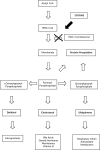Effects of statins on skeletal muscle: a perspective for physical therapists
- PMID: 20688875
- PMCID: PMC2949584
- DOI: 10.2522/ptj.20090251
Effects of statins on skeletal muscle: a perspective for physical therapists
Abstract
Hyperlipidemia, also known as high blood cholesterol, is a cardiovascular health risk that affects more than one third of adults in the United States. Statins are commonly prescribed and successful lipid-lowering medications that reduce the risks associated with cardiovascular disease. The side effects most commonly associated with statin use involve muscle cramping, soreness, fatigue, weakness, and, in rare cases, rapid muscle breakdown that can lead to death. Often, these side effects can become apparent during or after strenuous bouts of exercise. Although the mechanisms by which statins affect muscle performance are not entirely understood, recent research has identified some common causative factors. As musculoskeletal and exercise specialists, physical therapists have a unique opportunity to identify adverse effects related to statin use. The purposes of this perspective article are: (1) to review the metabolism and mechanisms of actions of statins, (2) to discuss the effects of statins on skeletal muscle function, (3) to detail the clinical presentation of statin-induced myopathies, (4) to outline the testing used to diagnose statin-induced myopathies, and (5) to introduce a role for the physical therapist for the screening and detection of suspected statin-induced skeletal muscle myopathy.
Figures
Similar articles
-
Statin induced myopathy.J Insur Med. 2009;41(2):132-5. J Insur Med. 2009. PMID: 19845216
-
Statin myopathy: a review of recent progress.Curr Opin Rheumatol. 2010 Nov;22(6):644-50. doi: 10.1097/BOR.0b013e32833f0fc7. Curr Opin Rheumatol. 2010. PMID: 20827205 Review.
-
Statin-associated myopathy.JAMA. 2003 Apr 2;289(13):1681-90. doi: 10.1001/jama.289.13.1681. JAMA. 2003. PMID: 12672737 Review.
-
Risk factors and drug interactions predisposing to statin-induced myopathy: implications for risk assessment, prevention and treatment.Drug Saf. 2010 Mar 1;33(3):171-87. doi: 10.2165/11319380-000000000-00000. Drug Saf. 2010. PMID: 20158283 Review.
-
Modeling statin myopathy in a human skeletal muscle microphysiological system.PLoS One. 2020 Nov 25;15(11):e0242422. doi: 10.1371/journal.pone.0242422. eCollection 2020. PLoS One. 2020. PMID: 33237943 Free PMC article.
Cited by
-
A Comprehensive Review of Modifiable Cardiovascular Risk Factors and Genetic Influences in Dementia Prevention.Cureus. 2023 Nov 7;15(11):e48430. doi: 10.7759/cureus.48430. eCollection 2023 Nov. Cureus. 2023. PMID: 38074067 Free PMC article. Review.
-
Statins Neuromuscular Adverse Effects.Int J Mol Sci. 2022 Jul 28;23(15):8364. doi: 10.3390/ijms23158364. Int J Mol Sci. 2022. PMID: 35955495 Free PMC article. Review.
-
Adverse drug reactions of statin therapy in China from 1989 to 2019: a national database analysis.Eur J Hosp Pharm. 2023 Mar;30(e1):e82-e89. doi: 10.1136/ejhpharm-2022-003333. Epub 2022 Jun 21. Eur J Hosp Pharm. 2023. PMID: 35728952 Free PMC article.
-
The effect of statins on falls and physical activity in people aged 65 and older: A systematic review.Eur J Clin Pharmacol. 2024 May;80(5):657-668. doi: 10.1007/s00228-024-03632-6. Epub 2024 Feb 14. Eur J Clin Pharmacol. 2024. PMID: 38353691
-
Metabolic Syndrome and Abnormal Peri-Organ or Intra-Organ Fat (APIFat) Deposition in Chronic Obstructive Pulmonary Disease: An Overview.Metabolites. 2020 Nov 15;10(11):465. doi: 10.3390/metabo10110465. Metabolites. 2020. PMID: 33203192 Free PMC article. Review.
References
-
- Rosamond W, Flegal K, Furie K, et al. Heart disease and stroke statistics, 2008 update: a report from the American Heart Association Statistics Committee and Stroke Statistics Subcommittee. Circulation. 2008;117:e25–146 - PubMed
-
- Schaefer EJ, Lamon-Fava S, Cohn SD, et al. Effects of age, gender, and menopausal status on plasma low density lipoprotein cholesterol and apolipoprotein B levels in the Framingham Offspring Study. J Lipid Res. 1994;35:779–792 - PubMed
-
- Schaefer EJ, Lamon-Fava S, Ordovas JM, et al. Factors associated with low and elevated plasma high density lipoprotein cholesterol and apolipoprotein A-I levels in the Framingham Offspring Study. J Lipid Res. 1994;35:871–882 - PubMed
-
- Gardner CD, Winkleby MA, Fortmann SP. Population frequency distribution of non-high-density lipoprotein cholesterol (Third National Health and Nutrition Examination Survey [NHANES III], 1988–1994). Am J Cardiol. 2000;86:299–304 - PubMed
Publication types
MeSH terms
Substances
Grants and funding
LinkOut - more resources
Full Text Sources
Other Literature Sources
Medical
Research Materials


